 W
WSwimming is the self-propulsion of a person through water, usually for recreation, sport, exercise, or survival. Locomotion is achieved through coordinated movement of the limbs and the body. Humans can hold their breath underwater and undertake rudimentary locomotive swimming within weeks of birth, as a survival response.
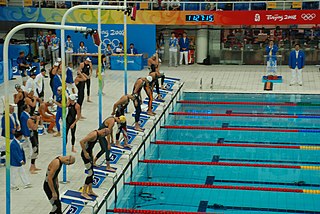 W
WSwimming is an individual or team racing sport that requires the use of one's entire body to move through water. The sport takes place in pools or open water. Competitive swimming is one of the most popular Olympic sports, with varied distance events in butterfly, backstroke, breaststroke, freestyle, and individual medley. In addition to these individual events, four swimmers can take part in either a freestyle or medley relay. A medley relay consists of four swimmers who will each swim a different stroke, ordered as backstroke, breaststroke, butterfly and freestyle.
 W
WAn aquathlon is a multisport race consisting of continuous run and swim elements. Competitors complete a swim immediately followed by a run over various distances. Athletes compete for fastest overall course completion, including the time transitioning between the disciplines.
 W
WAquatic locomotion is biologically propelled motion through a liquid medium. The simplest propulsive systems are composed of cilia and flagella. Swimming has evolved a number of times in a range of organisms including arthropods, fish, molluscs, reptiles, birds, and mammals.
 W
WThe bathing machine was a device, popular from the 18th century until the early 20th century, to allow people to change out of their usual clothes, change into swimwear, and wade in the ocean at beaches. Bathing machines were roofed and walled wooden carts rolled into the sea. Some had solid wooden walls, others canvas walls over a wooden frame, and commonly walls at the sides and curtained doors at each end.
 W
WDrowning is a type of suffocation induced by the submersion or immersion of the mouth and nose in a liquid. Most instances of fatal drowning occur alone or in situations where others present are either unaware of the victim's situation or unable to offer assistance. After successful resuscitation, drowning victims may experience breathing problems, vomiting, confusion, or unconsciousness. Occasionally, victims may not begin experiencing these symptoms for several hours after they are rescued. An incident of drowning can also cause further complications for victims due to low body temperature, aspiration of vomit, or acute respiratory distress syndrome.
 W
WThis is a list of articles about swimming in each country around the world. Most countries have two national championships per year, one in long course and one in short course. Some countries also have a national team championship.
 W
WCompetitive swimming in Britain started around 1830, mostly using breaststroke. Swimming was part of the first modern Olympic games in 1896 in Athens. In 1908, the world swimming association, Fédération Internationale de Natation (FINA), was formed.
 W
WInfant swimming is the phenomenon of human babies and toddlers reflexively moving themselves through water and changing their rate of respiration and heart rate in response to being submerged. The slowing of heart rate and breathing is called the bradycardic response. It is not true that babies are born with the ability to swim, though they have primitive reflexes that make it look like they are. Babies are not old enough to hold their breath intentionally or strong enough to keep their head above water, and cannot swim unassisted.
 W
WSwimming lessons are the process of learning to swim. In most countries there is a definition of a number of swimming levels that are reached in the process of the curriculum. The respective certificates of swimming tests are required for further training in aquatic abilities. Many countries have defined a minimum swimming level that children should reach by the end of primary education, in most cases with the help of school swimming classes being part of the normal curriculum.
 W
WMixed bathing is the sharing of a pool, beach or other place by swimmers of both sexes. Mixed bathing usually refers to swimming or other water-based recreational activities in public or semi-public facilities, such as hotel or holiday resort pool, in a non-sex segregated environment.
 W
WThe modern pentathlon is an Olympic sport that comprises five different events; fencing, freestyle swimming (200 m), equestrian show jumping, and a final combined event of pistol shooting and cross country running (3200 m). This last event is now referred to as the laser-run, since it alternates four legs of laser pistol shooting followed by an 800 m run. The event is inspired by the traditional pentathlon held during the ancient Olympics; as the original events were patterned on the skills needed by an ideal Greek soldier of the era, the modern pentathlon is similarly patterned on events representing the skills needed by cavalry behind enemy lines.
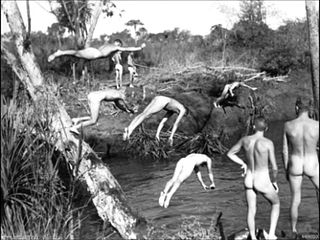 W
WNude swimming, or skinny dipping, is the practice of bathing naked, whether in natural bodies of water, in swimming pools, or in hot tubs.
 W
WThe Oceans Seven is a marathon swimming challenge consisting of seven open water channel swims. It was devised in 2008 as the swimming equivalent of the Seven Summits mountaineering challenge. It includes the North Channel, the Cook Strait, the Molokaʻi Channel, the English Channel, the Catalina Channel, the Tsugaru Strait and the Strait of Gibraltar.
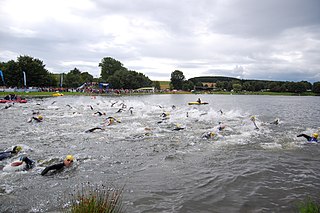 W
WOpen water swimming is a swimming discipline which takes place in outdoor bodies of water such as open oceans, lakes, and rivers.
 W
WParalympic swimming is an adaptation of the sport of swimming for athletes with disabilities. Paralympic swimmers compete at the Summer Paralympic Games and at other sports competitions throughout the world. The sport is governed by the International Paralympic Committee. Both men and women compete in Paralympic swimming, racing against competitors of their own gender. Swimming has been a part of the Paralympic program since the 1960 Summer Olympics in Rome, Italy.
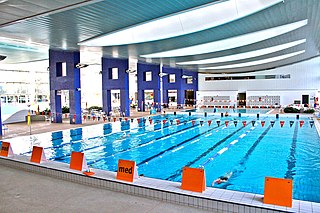 W
WRespiratory risks of indoor swimming pools can include coughing, wheezing, aggravated asthma, and airway hyper-responsiveness. The chemicals used for pool water disinfection can react with organic compounds in the water to create disinfection by-products or DBPs. Exposure to these DBPs are the potential cause for respiratory symptoms in swimmers. Multiple studies have shown the potential correlation between chronic exposure to DBPs and respiratory symptoms among competitive swimmers but more research is needed on the effects of these DBPs on recreational swimmers. The studies on recreational swimmers that have been done show a decreased risk for respiratory symptoms due to a decreased exposure to DBPs. Some studies have been done on the vulnerability of younger children and DBP exposure. Studies done on the vulnerability of younger children demonstrate that immature lungs are more likely to absorb more of these DBPs.
 W
WA snorkel is a device used for breathing air from above the surface when the wearer's head is face downwards in the water with the mouth and the nose submerged. It may be either separate or integrated into a swimming or diving mask. The integrated version is only suitable for surface snorkeling, while the separate device may also be used for underwater activities such as spearfishing, freediving, finswimming, underwater hockey, underwater rugby and for surface breathing with scuba equipment. A swimmer's snorkel is a tube bent into a shape often resembling the letter "L" or "J", fitted with a mouthpiece at the lower end and constructed of light metal, rubber or plastic. The snorkel may come with a rubber loop or a plastic clip enabling the snorkel to be attached to the outside of the head strap of the diving mask. Although the snorkel may also be secured by tucking the tube between the mask-strap and the head, this alternative strategy can lead to physical discomfort, mask leakage or even snorkel loss.
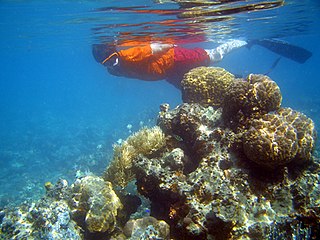 W
WSnorkeling is the practice of swimming on or through a body of water while equipped with a diving mask, a shaped breathing tube called a snorkel, and usually swimfins. In cooler waters, a wetsuit may also be worn. Use of this equipment allows the snorkeler to observe underwater attractions for extended periods with relatively little effort and to breathe while face-down at the surface.
 W
WSwimming injuries have many different causes, which can occur immediate or can occur as the result of a long-term swimming career. Some ways that swimmers can increase the risk of an injury are by overuse of a specific part of the body, lacking crucial flexibility and strength, etc. These injuries, like swimmer’s shoulder and breaststroker’s knee, cause pain to the swimmer in certain regions that permit necessary movement for the required precise technique. Although these injuries can halt a professional swimmer’s career, many can be treated and some can even be prevented. There are different procedures and exercises that can either prevent an injury or help with recovering from an injury. Many of the exercises are specific to the injury and vary in helpfulness according to the person and the technique used for the exercise.
 W
WThe Triple Crown of Open Water Swimming is a marathon swimming challenge consisting of three historically important swims:The English Channel, 33 km between France and England The Catalina Channel, 32.5 km between Catalina Island and the California mainland Manhattan Island Marathon Swim, a 48.5 km circumnavigation of Manhattan Island, New York City.
 W
WIn swimming, a turn is a reversal of direction of travel by a swimmer. A turn is typically performed when a swimmer reaches the end of a swimming pool but still has one or more remaining pool lengths to swim.
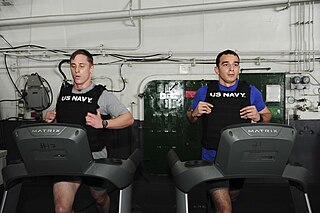 W
WWeighted clothing are garments that have heavy materials incorporated into them, to add weight to various parts of the body, usually as part of resistance training. The effect is achieved through attaching weighted pieces to the body which leave the hands free to grasp objects. Unlike with held weights or machines, weighted clothing can leave users more able to do a variety of movements and manual labour. In some cases certain weighted clothing can be worn under normal clothing, to disguise its use to allow exercise in casual environments.
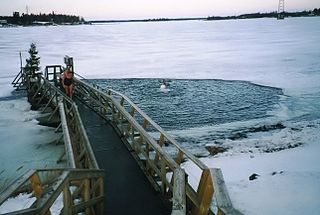 W
WWinter swimming is the activity of swimming during the winter season, typically in outdoor locations or in unheated pools or lidos. In colder countries, it may be synonymous with ice swimming, when the water is frozen over. This requires either breaking the ice or entering where a spring prevents the formation of ice. It may also be simulated by a pool of water at 0 °C (32 °F), the temperature at which water freezes.